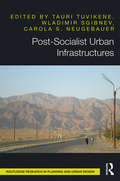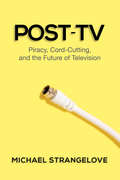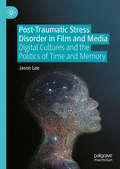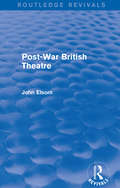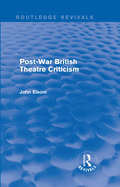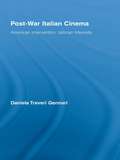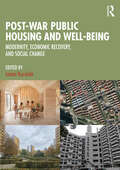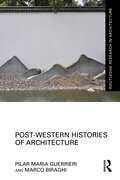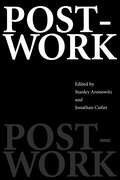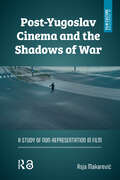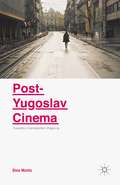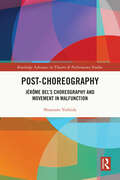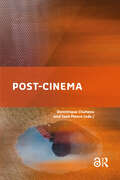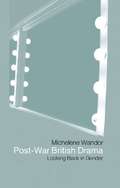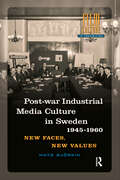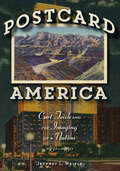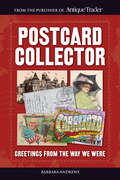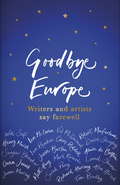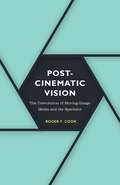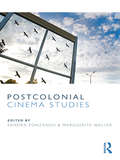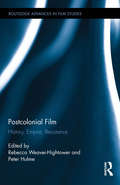- Table View
- List View
Post-Socialist Urban Infrastructures
by Wladimir Sgibnev Tauri Tuvikene Carola S. NeugebauerPost-Socialist Urban Infrastructures critically elaborates on often forgotten, but some of the most essential, aspects of contemporary urban life, namely infrastructures, and links them to a discussion of post-socialist transformation. As the skeletons of cities, infrastructures capture the ways in which urban environments are assembled and urban lives unfold. Focusing on post-socialist cities, marked by neoliberalisation, polarisation and hybridity, this book offers new and enriching perspectives on urban infrastructures by centering on the often marginalised aspects of urban research—transport, green spaces, and water and heating provision. Featuring cases from West and East alike, the book covers examples from Azerbaijan, Bulgaria, Serbia, Croatia, Germany, Russia, Georgia, Lithuania, Poland, the Czech Republic, Tajikistan, and India. It provides original insights into the infrastructural back end of post-socialist cities for scholars, planners and activists interested in urban geography, cultural and social anthropology, and urban studies.
Post-TV
by Michael StrangeloveIn the late 2000s, television no longer referred to an object to be watched; it had transformed into content to be streamed, downloaded, and shared. Tens of millions of viewers have "cut the cord," abandoned cable television, tuned into online services like Netflix, Hulu, and YouTube, and also watch pirated movies and programmes at an unprecedented rate. The idea that the Internet will devastate the television and film industry in the same way that it gutted the music industry no longer seems farfetched. The television industry, however, remains driven by outmoded market-based business models that ignore audience behaviour and preferences.In Post-TV, Michael Strangelove explores the viewing habits and values of the post-television generation, one that finds new ways to exploit technology to find its entertainment for free, rather than for a fee. Challenging the notion that the audience is constrained by regulatory and industrial regimes, Strangelove argues that cord-cutting, digital piracy, increased competition, and new modes of production and distribution are making audiences and content more difficult to control, opening up the possibility of a freer, more democratic, media environment.A follow-up to the award-winning Watching YouTube, Post-TV is a lively examination of the social and economic implications of a world where people can watch what they want, when they want, wherever they want.
Post-Traumatic Stress Disorder in Film and Media: Digital Cultures and the Politics of Time and Memory
by Jason LeeThis book expounds how post-traumatic stress disorder (PTSD) became so ubiquitous. The relationships between trauma, memory, and media, including the cultural, psychological, and social dimensions of PTSD are analysed. This work provides an examination of PTSD across diverse cultural contexts, shedding light on its profound impact on human experience and societal structures. This work addresses the role of social media internationally, the pornography industry, and conspiracy theories, in perpetuating trauma and shaping societal attitudes. From feature films, including Apocalypse Now, The Deer Hunter, and Jacob’s Ladder, to hit television shows such as the BBC’s Bodyguard, visual cultures have been instrumental in popularizing an understanding of PTSD. Often these are traditional “triumph over adversity” narratives. In others what is relevant is the wider postwar political landscape. Controversial wars have led to mental health problems for returning soldiers, depicted as part of a metaphoric wound for a nation. At its heart, America is concerned with the survival of the fittest, a Social Darwinist creed fused with manifest destiny and turbo capitalism. Any weaknesses, such as mental problems including PTSD, contradicted and challenged the essence of the pioneering American spirit. A book on PTSD at this moment is necessary, as the subject has become popularized and politicized, just as “madness” became a term to define an era. Through advocating for interdisciplinary approaches to foster healthier perspectives and support, here we come to a deeper understanding of how digital cultures have impacted the politics of time and memory.
Post-War British Theatre (Routledge Revivals)
by John ElsomSince the Second World War, we have witnessed exciting, often confusing developments in the British theatre. This book, first published in 1976, presents an enlightening, objective history of the many facets of post-war British theatre and a fresh interpretation of theatre itself. The remarkable and profound changes which have taken place during this period range from the style and content of plays, through methods of acting, to shapes of theatres and the organisational habits of managers. Two national theatres have been brought almost simultaneously into existence; while at the other end of the financial scale, the fringe and pub theatres have kicked their way into vigorous life. The theatre in Britain has been one of the post-war success stories, to judge by its international renown and its mixture of experimental vitality and polished experience. In this book Elsom presents an approach to the problems of criticism and appreciation which range beyond those of literary analysis.
Post-War British Theatre Criticism (Routledge Revivals)
by John ElsomThis book, first published in 1981, sets out the critical reaction to some fifty key post-war productions of the British theatre, as gauged primarily through the contemporary reviews of theatre critics. The plays chosen are each, in their different ways, important in their contribution to the development of the British theatre, covering the period from immediately after the Second World War, when British theatre fell into decline, through the revival of the late 1950s, to the time in which this book was first published, in which British theatre enjoyed a high international reputation for its diversity and quality. This book is ideal for theatre studies students, as well as for the general theatre-goer.
Post-War Homes: Mid-Century British Architecture
by Dominic BradburyPost-war housing across Britain is an extraordinary story of optimism, ambition and innovation.During the 1950s and 1960s, a combination of reconstruction, consumer-led demand and the rise of the Welfare State, saw an unprecedented building boom in housing and new homes. British architects embraced the challenge, seeking to build on the lessons of interwar Modernism while introducing fresh and original ideas of their own. They created mid-century New Towns, estates and houses, as well as many mid- and high-rise modern landmarks.Post-War Homes provides a major survey of this golden age of tectonic creativity, while focussing upon its most important, influential and engaging typologies.As homeowners and occupiers today continue to enjoy the design quality of their mid-century homes, this book celebrates the spirit of innovation and optimism in which such ambitious housing projects were designed and delivered.Features:30 illustrated case studies, including full-colour photography and historic imagery from the RIBA archive.A complete history, considering exemplary standalone homes, innovative mid and high-rise projects as well as estates and mixed-use communities.Landmark projects including: Ernoe Goldfinger's Trellick Tower, Denys Lasdun's Keeling House, Neave Brown's Alexandra Road, and Chamberlin, Powell & Bon's Golden Lane Estate.
Post-War Italian Cinema: American Intervention, Vatican Interests (Routledge Advances in Film Studies)
by Daniela Treveri GennariThrough a comparative approach of current theories developed on ideology and an analysis of official documents from the Vatican and the United States Department of State, the book investigates the decisive role that American production companies played in the development of the Italian film industry and their links to the Vatican. This analysis evaluates how the Italian production and distribution industries satisfied the American political and economic interests. American political and cultural ideology of the post-1945 era, is compared with the Roman Catholic ideology in order to assess their cultural propaganda. This is followed by studies of the roles played by key individuals, such as Giulio Andreotti, and institutions such as ANICA and A.G.I.S. involved in formulating the policies and regulations that affected the production and distribution of American and Italian films in the post-1945 era, as well as the involvement of the Roman Catholic Church in this process.
Post-War Public Housing and Well-Being: Modernity, Economic Recovery, and Social Change
by Izumi KuroishiThis collection illustrates the evolving role of housing as a symbol of modernity, a tool for economic recovery and a response to societal transitions. It argues that understanding earlier efforts to integrate well-being in the twentieth century can provide valuable insights for contemporary actors in the built environment who are working to address these issues today. As such, it explores and shines light on this lesser-known history, drawing on case studies, it focuses on the intersection of public housing, well-being and social change in the aftermath of the Second World War. With case studies from the UK, US, Singapore, Japan, Germany, China and Spain, this volume provides insights into how these countries have shaped the values, designs and institutions of their dwellings. By incorporating diverse cultural contexts, it contributes to a nuanced understanding of housing dynamics and well-being. Through a multidisciplinary lens, this volume encourages a re-evaluation of living conditions and fundamental values, emphasising the dynamic interplay between humans, their social environment and diverse living environments.This book is essential for scholars, researchers, professionals, students, policymakers and practitioners in cultural history, architecture, planning, urban studies, sociology, education and public policy.
Post-Western Histories of Architecture (Routledge Research in Architecture)
by Pilar Maria Guerrieri Marco BiraghiThis book seeks to provide an alternative post-Western perspective to the history of contemporary architecture. It puts forward detailed critical analyses of various areas of the world, including Europe, Latin America, Africa, China, Australia, India and Japan, where particular movements of architecture have developed as active ‘political acts’. The authors focus on a broad spectrum of countries, architectures and architects that have developed a design approach closely linked to the building context. The concept of context is broad and includes various economic, social, cultural, political and natural aspects. In all cases, the architects selected in this book have chosen to view context as an opportunity. However, each architect has considered certain specific aspects of context: some have been very attentive to the social context, others to material aspects or typological issues, and still others to aspects related to political visions or economic factors. The analysis critically highlights interesting, creative and respectful design approaches towards local conditions, such as sustainability in Nordic Europe, climate-conscious design in Africa, and the ‘bottom-up’ sensitivity of India. The book’s main aim is to retrace, through both theoretical arguments and case studies, the debate that focuses on politics and the environment. Thanks to its valuable examples, this book strives to make a conscious contribution to establishing a bulwark against the current ‘flattening-out’ processes that architecture is experiencing. This book will be of relevance to researchers, teachers and students interested in the history of architecture, architecture and planning, and postcolonial studies.
Post-Westerns: Cinema, Region, West (Postwestern Horizons)
by Neil CampbellDuring the post-World War II period, the Western, like America&’s other great film genres, appeared to collapse as a result of revisionism and the emergence of new forms. Perhaps, however, as theorists like Gilles Deleuze suggest, it remains, simply &“maintaining its empty frame.&” Yet this frame is far from empty, as Post-Westerns shows us: rather than collapse, the Western instead found a new form through which to scrutinize and question the very assumptions on which the genre was based. Employing the ideas of critics such as Deleuze, Jacques Derrida, and Jacques Rancière, Neil Campbell examines the haunted inheritance of the Western in contemporary U.S. culture. His book reveals how close examination of certain postwar films—including Bad Day at Black Rock, The Misfits, Lone Star, Easy Rider, Gas Food Lodging, Down in the Valley, and No Country for Old Men—reconfigures our notions of region and nation, the Western, and indeed the West itself.Campbell suggests that post-Westerns are in fact &“ghost-Westerns,&” haunted by the earlier form&’s devices and styles in ways that at once acknowledge and call into question the West, both as such and in its persistent ideological framing of the national identity and values.
Post-Work
by Stanley Aronowitz Jonathan CutlerIn Post-Work, Stanley Aronowitz and Jonathan Cutler have collected essays from a variety of scholars to discuss the dreary future of work. The introduction, The Post-Work Manifesto,, provides the framework for a radical reappraisal of work and suggests an alternative organization of labor. The provocative essays that follow focus on specific issues that are key to our reconceptualization of the notion and practice of work, with coverage of the fight for shorter hours, the relationship between school and work, and the role of welfare, among others. Armed with an interdisciplinary approach, Post-Work looks beyond the rancorous debates around welfare politics and lays out the real sources of anxiety in the modern workplace. The result is an offering of hope for the future--an alternative path for a cybernation, where the possibility of less work for a better standard of living is possible.
Post-Yugoslav Cinema and the Shadows of War: A Study of Non-Representation in Film (Film Culture in Transition)
by Asja MakarevicBosnia-Herzegovina is still considered a post-war country. The concept of post-war implies that the country and its people are tied more strongly to the past than they are oriented towards the future. Paradoxically, as long as the future is kept at bay and the post-war condition kept alive, Bosnia maintains a certain significance on the global scene. However, living in the temporal vacuum of the post-war condition cannot be a long-term perspective. A range of post-Yugoslav films provides spectators with images that offer innovative approaches to the collective past, while simultaneously reframing contemporary experience. This study proposes to call non-representational images appears to offer a more dynamic relationship to the past and the present, while reflecting complex processes of the formation of identity, memory, guilt, and responsibility. But if these dynamics are inherent in non-representational images, is there a way in which they can contribute to overcoming the post-war condition?
Post-Yugoslav Cinema: Towards a Cosmopolitan Imagining
by Dino MurticDrawing primarily on selected filmic texts from former-Yugoslavia, the book examines key social and political events that triggered the Yugoslav wars in the 1990s. Yugoslav politics and society are set within the broader artistic and cinematic strategies that helped stabilise post-Yugoslav territories strategies that were part of the national desire of looking forward to a time of 'perpetual peace' and its subsequent cosmopolitan norms. It argues that filmic texts demonstrate the degree to which nationalism was at the heart of the violent disintegration of Yugoslavia. Yet, the concern of the argument is not simply to offer a filmic critique but to develop an alternative to nationalism; namely, a theoretical framework through which cosmopolitan humanism is at the forefront of addressing former Yugoslavia's political wounds.
Post-choreography: Jérôme Bel’s Choreography and Movement in Malfunction (ISSN)
by Shuntaro YoshidaThis book sheds light on the practice of French choreographer Jérôme Bel, who is active in the fields of performing arts and contemporary art.Shuntaro Yoshida examines a case study of collective creation involving the choreographer and a group of amateur workshop participants. The focus is on Atelier Danse et Voix (Dance and Voice Workshop) (2014) and workshops held with local diverse participants in Brussels, Venice, and Munich after the cancellation of the Dance and Voice Workshop. This study elucidates Bel’s creative method by exploring the relationship between choreographer and participants in a situation where the typical framework of actors has been expanded. The focus of the case study is not so much the choreographic methodology itself, but the relationship between the method and the participants and the ways in which the choreographer cedes creative decision-making power to participants. In order to investigate Bel’s creative method, this study makes use of participant observation field notes taken during a rehearsal. Additional data sources include Bel’s emailed materials, performance programs, and interviews with participants.This book will be of great interest to students and scholars in theater, performance, and dance studies.
Post-cinema: Cinema in the Post-art Era (The Key Debates: Mutations and Appropriations in European Film Studies)
by Dominique Chateau and José MourePost-cinema designates a new way of making films. It is time to ask whether this novelty is complete or relative and to evaluate to what extent it represents a unitary or diversified current. The book proposes to integrate the post-cinema question within the post-art question in order to study the new ways of making filmic images. The issue will be considered at three levels: the impression of post-art on regular films; the relocation (Casetti) of the same films that can be seen using devices of all kinds in conditions more or less removed from the dispositif of the theater; the integration of cinema into contemporary art in all kinds of forms of creation and exhibition, parallel to the integration of contemporary art in regular cinema.
Post-feminist Impasses in Popular Heroine Television
by Alison HorburyAlison Horbury investigates the reprisal of the myth of Persephone - a mother-daughter plot of separation and initiation - in post-feminist television cultures where, she argues, it functions as a symptom expressing a complex around the question of sexual difference - what Lacan calls 'sexuation', where this question has been otherwise foreclosed. She takes four television heroines dramatizing this Persephone symptom - Ally McBeal, Sydney Bristow, Veronica Mars, and Meredith Grey - to showwhat is unconscious in this symptom, and identifies an impasse in feminist cultural criticisms as they respond to post-feminist cultures on the topic of 'woman'. She introduces psychoanalytic approaches to the novel to rethink the engagement of audiences with this Persephone symptom, and suggests that post-feminist discourses manifesting in Persephone's story offer us a cultural symptom that, when analysed, offers us new reflections on feminism today.
Post-war British Drama: Sexuality And The Family In Post-war British Drama (Routledge Revivals Ser.)
by Michelene WandorIn this extensively revised and updated edition of her classic work, Look Back in Gender, Michelene Wandor confirms the symbiotic relationship between drama and gender in a provocative look at key, representative British plays from the last fifty years. Repositioning the text at the heart of hteatre studies, Wandor surveys plays by Ayckbourn, Beckett, Churchill, Daniels, Friel, Hare, Kane, Osborne, Pinter, Ravenhill, Wertenbaker, Wesker and others. Her nuanced argument, central to any analysis of contemporary drama, discusses: *the imperative of gender in the playwright's imagination *the function of gender as a major determinant of the text's structural and narrative drives *the impact of socialism and feminism on post-war British drama, and the relevance of feminist dynamics in drama *differences in the representation of the fmaily, sexuality and the mother, before and after 1968 *the impact of the slogan that the 'personal is political' on contemporary form and content.
Post-war Industrial Media Culture in Sweden, 1945-1960: New Faces, New Values (Film Culture in Transition)
by Mats BjörkinDuring the 1950s in Sweden, companies aiming for international markets demanded new theories and methods of communication. Ideas regarding cybernetics, systems analysis, new accounting practices, and budgetary principles as well as theories of information, communication, marketing, public relations, and organization were discussed at conferences and seminars and in courses, articles, and books. At the same time, new technologies were introduced that changed corporate communication, from loose-leaf accounting systems to mechanical and electronic business machines, from written texts and oral presentations to slide shows, audio tapes, films, television, and flannelgraphs. By looking at a vast array of objects and relations related to uses of media technologies in Swedish industry from the end of World War II to the breakthrough of television, this book shows what happened in the glitches between mass communication and interaction, and how Swedish industry after the war worked to disrupt established understandings of communication.
Postcard America: Curt Teich and the Imaging of a Nation, 1931–1950
by Jeffrey L. MeikleThis illustrated history of the colorized linen postcards of the 1930s and &’40s is &“an incredible tour . . . A veritable treasure trove of American culture&” (Crave Online). From the Great Depression through the early postwar years, any postcard sent in America was more than likely a &“linen&” card. Colorized in vivid, often exaggerated hues and printed on card stock embossed with a linen-like texture, linen postcards celebrated the American scene with views of majestic landscapes, modern cityscapes, roadside attractions, and other notable features. These colorful images portrayed the United States as shimmering with promise, quite unlike the black-and-white worlds of documentary photography or Life magazine. Linen postcards were enormously popular, with close to a billion printed and sold. Postcard America offers the first comprehensive study of these cards and their cultural significance. Drawing on the production files of Curt Teich & Co. of Chicago, the originator of linen postcards, Jeffrey L. Meikle reveals how photographic views were transformed into colorized postcard images—often by means of manipulation—adding and deleting details or collaging bits and pieces from several photos. He presents two extensive portfolios of postcards—landscapes and cityscapes—that comprise a representative iconography of linen postcard views. For each image, Meikle explains the postcard&’s subject, describes aspects of its production, and places it in social and cultural contexts. In the concluding chapter, he shifts from historical interpretation to a contemporary viewpoint, considering nostalgia as a motive for collectors and others who are fascinated today by these striking images.
Postcard Collector
by Barbara AndrewsAn exciting overview of the manufacturers, design and subject matter used in 19th and 20th century American postcards.
Postcards to Europe: The unique must-have collection
by VariousThis is not a book about politics. It is a book about what makes us British, and what makes us European.Spend time with some of your favourite writers and artists in this truly unique collection spanning everything from art, language, food, music and movies, to war, literature, driving, nudity, geography, smoking and nature.Featuring pieces of exceptional quality from some of our most treasured novelists, historians, journalists, poets and artists, including: Jessie Burton, Richard Herring, Alain de Botton, Tom Bradby, Val McDermid, Matt Haig, Afua Hirsch, Lionel Shriver, Sarah Perry, Sanjeev Bhaskar, Ian Rankin, Owen Jones, Mark Kermode, Robert Macfarlane, Chris Riddell, Former Prime Minister Jim Hacker and many more.A must-read for anyone who wants to understand the times we live in, our relationship with the continent, and ourselves.* * * * *INCLUDES PIECES BY:Yasmin Alibhai-Brown, Sanjeev Bhaskar, Tom Bradby, Jessie Burton, Ben Collins (aka The Stig), Colonel Tim Collins, Robert Crampton, Adam Dant, Alain de Botton, Kate Eberlen, Matt Frei, Nicci French, Simon Garfield, Jonathan Lynn writing as Former Prime Minister Jim Hacker, Matt Haig, Richard Herring, Jennifer Higgie, Afua Hirsch, Owen Jones, Oliver Kamm, Alex Kapranos, Mark Kermode, Hari Kunzru, Olivia Laing, Marie Le Conte, Amy Liptrot, Robert Macfarlane, Henry Marsh, Val McDermid, Ian McEwan, Hollie McNish, Kate Mosse, Jenni Murray, Sarah Perry, Ian Rankin, Jacob Rees-Mogg, Cathy Rentzenbrink, Chris Riddell, Andrew Roberts, Will Self, David Shrigley, Lionel Shriver, Sunny Singh, Ece Temelkuran, Rob Temple, Bee Wilson, Sarah Winman
Postcinematic Vision: The Coevolution of Moving-Image Media and the Spectator (Posthumanities #54)
by Roger F. CookA study of how film has continually intervened in our sense of perception, with far-ranging insights into the current state of lived experience How has cinema transformed our senses, and how does it continue to do so? Positing film as a stage in the long coevolution of human consciousness and visual technology, Postcinematic Vision offer a fresh perspective on the history of film while providing startling new insights into the so-called divide between cinematic and digital media.Starting with the argument that film viewing has long altered neural circuitry in our brains, Roger F. Cook proceeds to reevaluate film&’s origins, as well as its merger with digital imaging in the 1990s. His animating argument is that film has continually altered the relation between media and human perception, challenging the visual nature of modern culture in favor of a more unified, pan-sensual way of perceiving. Through this approach, he makes original contributions to our understanding of how mediation is altering lived experience.Along the way, Cook provides important reevaluations of well-known figures such as Franz Kafka, closely reading cinematic passages in the great author&’s work; he reassesses the conventional wisdom that Marshall McLuhan was a technological determinist; and he lodges an original new reading of The Matrix. Full of provocative and far-reaching ideas, Postcinematic Vision is a powerful work that helps us see old concepts anew while providing new ideas for future investigation.
Postcolonial Artists and Global Aesthetics
by Akinwumi AdesokanWhat happens when social and political processes such as globalization shape cultural production? Drawing on a range of writers and filmmakers from Africa and elsewhere, Akin Adesokan explores the forces at work in the production and circulation of culture in a globalized world. He tackles problems such as artistic representation in the era of decolonization, the uneven development of aesthetics across the world, and the impact of location and commodity culture on genres, with a distinctive approach that exposes the global processes transforming cultural forms.
Postcolonial Cinema Studies
by Sandra Ponzanesi Marguerite WallerThis collection of essays foregrounds the work of filmmakers in theorizing and comparing postcolonial conditions, recasting debates in both cinema and postcolonial studies. Postcolonial cinema is presented, not as a rigid category, but as an optic through which to address questions of postcolonial historiography, geography, subjectivity, and epistemology. Current circumstances of migration and immigration, militarization, economic exploitation, racial and religious conflict, enactments of citizenship, and cultural self-representation have deep roots in colonial/postcolonial/neocolonial histories. Contributors deeply engage the tense asymmetries bequeathed to the contemporary world by the multiple,diverse, and overlapping histories of European, Soviet, U.S., and multi-national imperial ventures. With interdisciplinary expertise, they discover and explore the conceptual temporalities and spatialities of postcoloniality, with an emphasis on the politics of form, the ‘postcolonial aesthetics’ through which filmmakers challenge themselves and their viewers to move beyond national and imperial imaginaries. Contributors include: Jude G. Akudinobi, Kanika Batra, Ruth Ben-Ghiat, Shohini Chaudhuri, Julie F. Codell, Sabine Doran, Hamish Ford, Claudia Hoffmann, Anikó Imre, Priya Jaikumar, Mariam B. Lam, Paulo de Medeiros, Sandra Ponzanesi, Richard Rice, Mireille Rosello and Marguerite Waller.
Postcolonial Film: History, Empire, Resistance (Routledge Advances in Film Studies #30)
by Peter Hulme Rebecca Weaver-HightowerPostcolonial Film: History, Empire, Resistance examines films of the later twentieth and early twenty-first centuries from postcolonial countries around the globe. In the mid twentieth century, the political reality of resistance and decolonization lead to the creation of dozens of new states, forming a backdrop to films of that period. Towards the century’s end and at the dawn of the new millennium, film continues to form a site for interrogating colonization and decolonization, though against a backdrop that is now more neo-colonial than colonial and more culturally imperial than imperial. This volume explores how individual films emerged from and commented on postcolonial spaces and the building and breaking down of the European empire. Each chapter is a case study examining how a particular film from a postcolonial nation emerges from and reflects that nation’s unique postcolonial situation. This analysis of one nation’s struggle with its coloniality allows each essay to investigate just what it means to be postcolonial.
